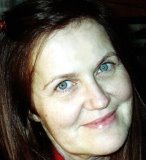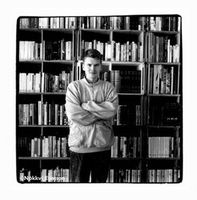Sunday, October 30, 2005
Erró
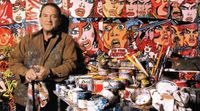

From Wikipedia, the free encyclopedia:
"Erró (born Guðmundur Guðmundsson in 1932 in Ólafsvík, Iceland) is a postmodern artist. He studied art in Norway and in Italy, and has resided in Paris, Thailand and on the island of Formentera for most of his life. In 1989 he donated a large collection of his works to the Reykjavík Art Museum, which has put part of it on permanent display and opened a website where the whole collection can be visited."
-- Left: Kirkjubæjarklaustur -- -- Right: Systrastapi --
Erró, or Guðmundur, as he was then still called, was brought up in Kirkjubæjarklaustur, the place where I lived most of my childhood, by his mother and foster-father, along with his three half-brothers and a half-sister (they lived in the little house far to the right in the photo above). I remember him vaguely as a very handsome, dark young man, that came on a visit and later went abroad to study painting. In his childhood home they had some mosaic pictures made by him and also I remember a picture of Systrastapi on the wall on his fosterfathers office, that Guðmundur had drawn as a teenager. His mother was a beautiful and kind woman with white hair, with an air of quiet gentility about her.
Erró, or Guðmundur, as he was then still called, was brought up in Kirkjubæjarklaustur, the place where I lived most of my childhood, by his mother and foster-father, along with his three half-brothers and a half-sister (they lived in the little house far to the right in the photo above). I remember him vaguely as a very handsome, dark young man, that came on a visit and later went abroad to study painting. In his childhood home they had some mosaic pictures made by him and also I remember a picture of Systrastapi on the wall on his fosterfathers office, that Guðmundur had drawn as a teenager. His mother was a beautiful and kind woman with white hair, with an air of quiet gentility about her.
Thursday, October 27, 2005
Ási í Bæ
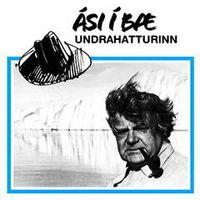 "The Wonder Hat"
"The Wonder Hat" "The Peoples Poet":
-- I know you will come tonight --
even though you went so quickly last night.
I don´t belive your words
-- as two twinkling stars told me otherwise! --
(my humble translation)
Ási í Bæ
(Adapted from Wikipedia)
Ástgeir Kristinn Ólafsson, better known as Ási í Bæ was born
27. febrúar, 1914. As a child he lived in Litlibær in the Westman Islands. He was very young when he started going to sea with his father in an open motorboat.
"Out of the Summer Seas,
He graduated from the Cooperative College of Iceland. He worked as a clerk in the Westman Islands for a while, but most of his life he was a seaman.In 1968 he moved with his family to Reykjavík where he worked as editor of the comic and satire (often political) magazine Spegillinn (The Mirror).
Ási was known all over the country for his songs and lyrics, as a singer of songs and a highly productive writer, especially after he quit going to sea.
His co-operation with poets/writers Árni úr Eyjum, Loftur Guðmundsson and Oddgeir Kristjánsson became famous and produced songs (more often than not composed for the "Þjóðhátíð" in the Westman Islands) that the Icelandic nations still knows and cherishes.
Songs like Sólbrúnir vangar (Suntaned Cheeks) og Ég veit þú kemur (I know you will come).
He was the writer of many books, for example Sá hlær best... (He laughs best...) where he tells about the adventures of his life, Granninn í vestri (The Neighbour in the West), a travellogue from Greenland, Breytileg átt (Shifting Wind), a novel, Eyjavísur (Island songs), and book of short stories Sjór, öl og ástir (Sea, beer and love). He also produced a record, Undrahatturinn (The Wonder Hat), where he sings his own songs and lyrics, accompanying himself on the guitar.
He died in Reykjavík, at the age of 71, in the spring of 1985.


His daughter is Kristín Ástgeirsdóttir, a historian and former member of Alþingi, the Icelandic legislative assembly, where she represented
The Women´s Alliance. It was an alliance formed by Icelandic women in 1983, with the goal of promoting womens participation and increasing their status in politics and social affairs (She was also a graduate from the Mennatskólinn við Hamrahlíð in 1971, same year as I graduated from there!)
Bubbi
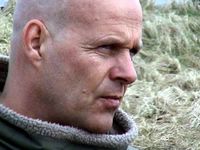
Bubbi Morthens: Born in Reykjavik in 1956, Ásbjörn "Bubbi" Morthens moved with his mother to Denmark at the age of 13. After failing to school he returned to Iceland and took up work in the fish factories. However, after becoming interested in the music of Woody Guthrie and Leadbelly, Bubbi went on to become one of Iceland's best-loved musicians, both as a member of the group "Utangardsmenn" (The Outsiders) and as a solo artist.
More about interesting Icelanders on:BEYOND NORTHERN IRAQ: mail2bni@yahoo.co.uk
Here is a link to some of Bubbi´s music. All his songs are in Icelandic.
Jón Gunnar Árnason
 Jón Gunnar Árnason 1931-1989
Jón Gunnar Árnason 1931-1989Born in Reykjavík. Studied at the Icelandic College of Art and Crafts in Reykjavík in 1945-46. Graduated as a mechanician from the Reykjavík Technical College 1952. Studied at the Hornsey College of fine Art in London 1965-67.
He is the artist of one of Reykjavík´s most famous sculptures,
"The Sun Voyager", that I think every traveler that comes to Reykjavík sees. It´s hard to miss, as it stands on its own on the seashore.
The photos of The Sun Voyager, with the exception of one other, are the only photos of his work that i was able to find on the internet. Then again, they were in plenty, only problem was which one to choose!
Here you can view some of the many photos of The Sun Voyager, from a group that calles itself The Sólfar Group

This is the other photo I managed to find
One of his works can indeed be viewed in my work-place Hótel Frón, a big cast iron work on the theme of The Battle of Persepolis (not vikings, even though everybody thinks so at first glance) upon one wall of the lobby!
Wednesday, October 26, 2005
Gerður Helgadóttir



Gerður Helgadóttir (1928-1975)
Gerður Helgadóttir was a versatile and prolific artist. She studied at the Icelandic College of Arts and Handicraft, then later in Florence, and in Paris where she spent most of her working life. With her geometric iron sculptures in the 1950s she established herself as a pioneer in three-dimensional abstract sculpture in Iceland. Later she worked exclusively using iron filaments which formed drawings in the sculptural space. Her art underwent a radical change when she began welding in bronze. The forms of her works became irregular and reveal an affinity with lyrical abstraction. After she visited Egypt in 1966, the influence of ancient Egyptian art can be discerned. From 1970 onwards she turned to massive works from plaster, clay and even concrete, characterized by simple circular forms and variations on the theme of motion. Many of these works were conceived as prototypes for large-scale sculptures.
Her works in stained glass are also remarkable. Her works, sculptures, mosaics and stained glass vindows can be widely viewed in and outside churches and official buildings in Iceland.
Gerður´s works on the internet.

Kópavogur Art Museum – Gerðarsafn, is one of Iceland's newest art museums, inaugurated in 1994, and the largest outside Reykjavík. Its collection comprises some 2,500 works. The Gerður Helgadóttir collection, donated to the town of Kópavogur by the heirs of the sculptress in 1977, contains around 1,400 works.
Another 300 works are in the bequest by illustrator Barbara Árnason and painter/sculptor Magnús Á. Árnason. Other works in the collection have been purchased by Kópavogur Arts and Culture Committee and are almost exclusively by Icelandic artists. In 2001, Kópavogur Art Museum took custody of the private collection owned by Þorvaldur Guðmundsson and his wife Ingibjörg Guðmundsdóttir. Different exhibitions are compiled every year from the more than 1,000 works that make up this largest private collection in Iceland. A wide range of exhibitions of Icelandic modern and contemporary art are staged at the museum and international exhibitions are also held in cooperation with museums and institutes from other countries.



Skálholtskirkja
Works by Gerður in Skálholt Church.
A family of artists:

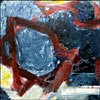
The father Elías B. Halldórsson is a very talented painter
and a great teller of stories.
I have myself listened to him tell a story, it was quite an experience!
All his three sons are artists:

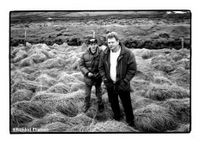

His first son Sigurlaugur Elísson is a painter and a poet.
His son Rökkvi is with him on the photo.
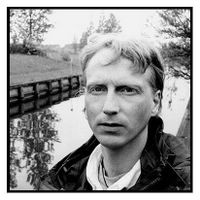

The third and youngest son is Nökkvi Elíasson, who took the photos in this post.
You can view more of his photographic skills by clicking on this: link.
Guðrún Helgadóttir

Guðrún Helgadóttir is one of the most prominent writers of children's books in Iceland.
She received The Nordic Children's Book Award in 1992 and among her other awards are the Thorbjörn Egner Fund Prize and IBBY Iceland Award; she was also nominated twice for the H.C. Andersen Award. She has written nineteen children´s books, many of whom have been translated into foreign languages, three plays and a novel, "Oddaflug", published year 2000.
Guðrún represented the People's Alliance on Reykjavík City Council 1978-1982 and was a member of Alþingi, the Icelandic legislative assembly 1979-1995. She was Speaker of the Althing 1988-1991, the first woman to hold that position.
Here is a complete list (sorry, not available in English as yet!) of Guðrún´s works, translations of her books, awards and recognitions.
Two of Guðrún´s most popular books:
A Giant Love Story

(Ástarsaga úr fjöllunum, 1981)
One of Iceland's most popular children's books. It was first published in 1981 and has since been translated into several other languages. It is a story about Icelandic trolls, filled with love, compassion and humour which appeals to children all over the world. Beautifully illustrated by Brian Pilkington.
(You can see some more of B. P.´s work on my site about trolls!)
Sold to: Norway (Cappelen), Denmark (Sesam), USA (Charolrhoda), Japan (Kaisei-Sha), Sweden (Opal), Faroe Islands (Nàlendi)
The Angels' Christmas Tree
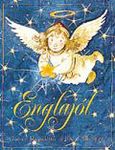
(Englajól, 1997)
While awaiting Christmas the angel-children decorate the most wonderful Christmas tree in the world - in their imagination. A wonderful fairytale with illustrations by Brian Pilkington, which has already aroused great interest in several countries. Available in English translation.
* * *
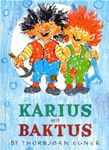

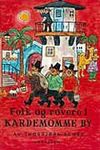
Thorbjörn Egner (1912-1990) is the author of the children´s book "Karius and Baktus" (teaching children the importance of brushing their teeth!) and the children´s musicals "Hakkebakke Forest" and "When the Robbers Came to Cardamom Town" (The Singing Town) that have been very popular for many years in Iceland and have been staged (and restaged regularly) several times both in The National Theatre of Iceland and in theatres all over the country.
